calsfoundation@cals.org
Paul Martin Heerwagen (1866–1955)
Paul Martin Heerwagen was an interior decorator who worked out of his Arkansas studios from 1891 to 1931. His work includes hotels, office and government buildings, churches, Masonic temples, and theaters throughout the South and Southwest. Some of his noteworthy projects include the Donaghey and Lafayette buildings and the Arkansas State Capitol in Little Rock (Pulaski County); the Peabody Hotel in Memphis, Tennessee; and the Strand Theatre in Shreveport, Louisiana. Fred Goza, an art critic for the Shreveport Times, was amazed at Heerwagen’s work when he toured the restored Strand in 1984; he wrote, “I was amazed that an American firm was responsible [for the interior decoration] because so much of the plaster work is so ornate that you feel some great European edifice must have been disassembled, brought to the States, and assembled once again by European artisans.”
Paul Heerwagen was born February 25, 1866, in the Kingdom of Bavaria (now part of Germany). He was one of four children of Christian Gotlieb, a pharmacist, and Mary (Stahl) Heerwagen. He received his formal education in Berlin, Germany, and traveled to the United States in 1881 by ship with his mother and three siblings. Although his sister died during the passage, Heerwagen, his two brothers, and their mother entered the United States like many immigrants, through Ellis Island. He settled briefly in Detroit, Michigan, where he studied interior design.
In 1891, Heerwagen moved to Little Rock, where he briefly ran a paint store and developed his interior design business. In 1893, he married Ida Killian of Little Rock. They had six children. One of their daughters, Margaret, studied art in New York and Paris, France, and assisted Heerwagen as an interior decorator and muralist.
In 1911, Heerwagen moved his family to Fayetteville (Washington County), and he established a studio there for his decorating business. One reason for the move was that Artemus Floyd Wolf, a real estate developer, had bought the Arkansas House—a display house at the 1904 World’s Fair in St. Louis, Missouri, used to showcase Arkansas products and industry—and wanted to move it to Fayetteville to live in. He apparently had asked for Heerwagen’s help in this endeavor. Another reason for the move was that the Heerwagens wanted their children to attend the University of Arkansas (UA) in Fayetteville.
In 1913, the Heerwagens bought a farm on the outskirts of Fayetteville; it served as the Paul M. Heerwagen Studios. The barn was used for preparing murals and other decorative work.
Heerwagen’s best-known interior design work in Arkansas was for the state capitol. He was awarded the state contract in June 1914 and completed the work by October. He was paid $10,000, an amount so small that part of his work constituted a donation.
Judge George Rose, a highly respected art collector and scholar, conferred with Heerwagen on the color scheme for the capitol and suggested the themes for the four murals that were placed into the lunettes. (Lunettes are crescent-shaped spaces in a vaulted roof or over a door or window.) The four murals were prepared at Heerwagen’s studios in Fayetteville, then shipped to Little Rock for completion and installation. Some evidence suggests that Frederick Ruple, an artist based in the Fayetteville area, painted these murals. The themes of the murals are justice, war, education, and religion. Much of the interior of the capitol was restored to its 1914 appearance during restoration work completed in 2000.
Heerwagen received four patents, including one in 1901 for an acoustic tile that could be painted to suit the décor of the room in which it was installed. In the 1930s, he entered an agreement with the Celotex and Monsanto corporations, allowing them to use his patent.
During World War I, the federal government closely scrutinized Americans of German descent, including Heerwagen, who discovered that the government was opening and reading his mail. To show his support for the U.S. war effort, he developed a type of paint for use on airplanes to help shed water and ice. He received a letter of commendation for this contribution. During World War II, Heerwagen occasionally visited German prisoners of war at a POW camp in the Springdale (Washington County) area.
Heerwagen died March 17, 1955, in Fayetteville, where he had stayed during his retirement. He is buried in Evergreen Cemetery in Fayetteville.
For additional information:
Campbell, William S. One Hundred Years of Fayetteville. Jefferson City, MO: 1928.
Johnson, Antoinette Fiduccia. “Paul Martin Heerwagen, 1883–1938: Exploring Architectural, Ornamental, Social, and Cultural Heritage through Interior Decoration.” PhD diss., Arkansas State University, 2014.
Thomas, David Y. Arkansas and its People. Vol. 3. New York: The American Historical Society, Inc., 1930.
W. Russ Aikman
University of Texas at Arlington
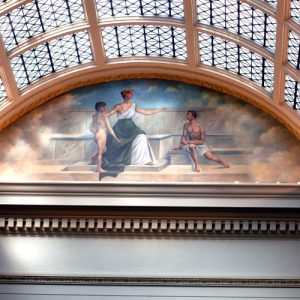 Education, Mural by Paul Heerwagen
Education, Mural by Paul Heerwagen 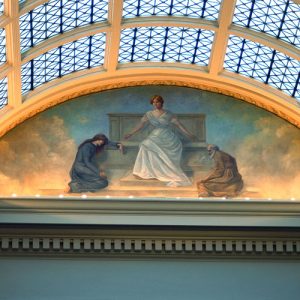 Religion, Mural by Paul Heerwagen
Religion, Mural by Paul Heerwagen 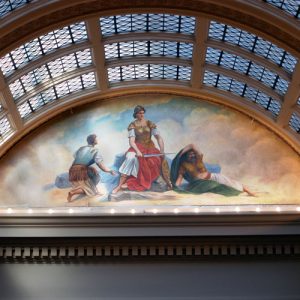 War, Mural by Paul Heerwagen
War, Mural by Paul Heerwagen 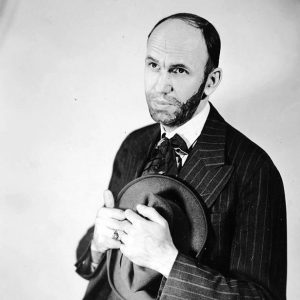 Paul Martin Heerwagen
Paul Martin Heerwagen  Justice, Mural by Paul Heerwagen
Justice, Mural by Paul Heerwagen 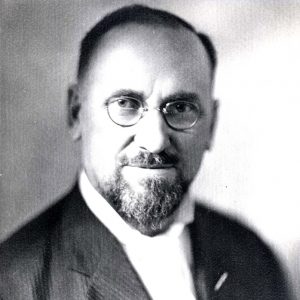 Paul M. Heerwagen
Paul M. Heerwagen 



He’s my great-great-grandpa.
Paul Heerwagen’s son, also Paul, was our neighbor on North Washington Ave. in Fayetteville’s historic district from 1967 until his death. He and his wife, Adele, were kind and interesting people. He wrote several books on historical topics, mostly self-published.